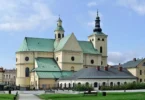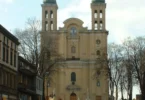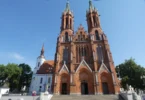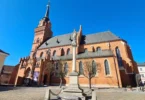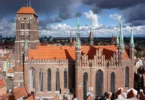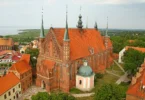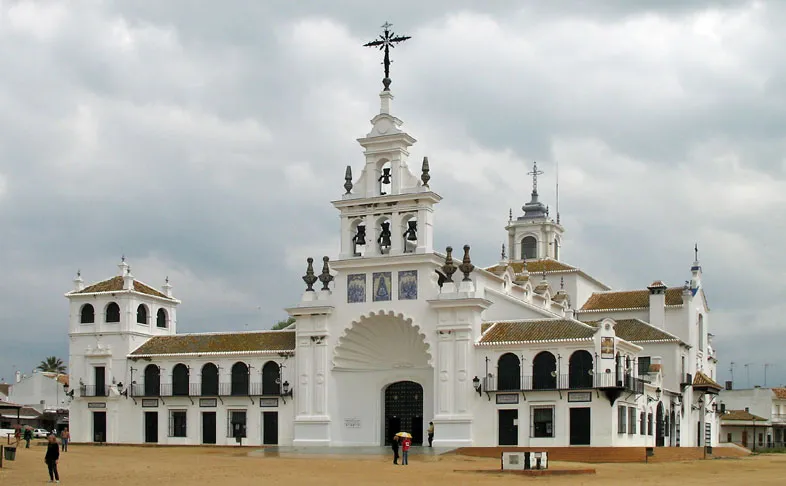
Introduction
The Hermitage of El Rocío (Spanish: Ermita del Rocío or Ermita de El Rocío) also known as Santuario de Nuestra Señora del Rocío (Sanctuary of Our Lady of Rocío, Huelva) is a hermitage at El Rocío in the countryside of Almonte, Province of Huelva, Andalusia, Spain. The hermitage is home to the Virgin of El Rocío (Spanish: Virgen del Rocío), a small, much-venerated carved wood statue, and is the destination of an annual procession/pilgrimage on the second day of the Pentecost, known as the Romería de El Rocío, connected to the veneration of the Virgin of El Rocío. In recent years the Romería has brought together roughly a million pilgrims each year.
The pilgrimage dates from 1653, when the Virgin of Las Rocinas was appointed patron saint of Almonte. Originally it took place on 8 September. Since 1758, the Virgin has been known as the Virgin of El Rocío, and the pilgrimage has taken place on the second day of Pentecost.
Although there has been a hermitage on this site for centuries, the present hermitage building was designed by architects Antonio Delgado y Roig and Alberto Balbontín de Orta, designed in 1961 and built in stages over the next two decades.
Perhaps the most spectacular romeria is the one devoted to the Virgen del Rocío, popularly called “El Rocio” for short. Nearly a million and a half people from all over Spain and Andalucia make the long journey to gather in the town of El Rocio.
In the marshlands of the Guadalquivir River delta (south of Almonte), close to Doñana National Park, where the statue of the “Madonna of the Dew” has been worshipped since 1280. The pilgrims come on horseback and in gaily-decorated covered wagons from all over the region, transforming the area into a colourful and noisy party.
The climax of the festival is the weekend before Pentecost Monday. (see dates)In the early hours of the Monday the Virgen del Rocio is brought out of the church. This remarkable event, where all the hermandades (brotherhoods from different towns and citires) compete to carry the statue, is always shown live on television.
History of Sanctuary of Our Lady of Rocío, Huelva

The historical chronicles say that King Alfonso X of Castile (Alfonso the Wise), present on the site in 1270, ordered the construction of a hermitage dedicated to the Virgin Mary in the place then known as Las Rocinas, which had recently been reconquered from the Muslims who at that time still ruled much of southern Spain.
The same chronicles say that attracted by the beauty of the area and its abundant deer, Alfonso established himself a hunting preserve there in 1269, first known as the Coto Real del Lomo del Grullo y Las Rocinas, which largely coincides with today’s Doñana National Park or Coto de Doñana.
The first Hermitage of El Rocío was a simple Mudéjar building constructed some time after Alfonso’s 1270 command, and built no later than 1300 (Juan Infante-Galán Zambrano says 1270–1284, but also says that the first firm documentary evidence of the hermitage dates from 1337). The statue of Our Lady of El Rocío certainly dates back to this building, though its precise date and origin are a matter of some controversy.
The original hermitage underwent repairs in 1612–1614, 1635, and 1658 and survived until the 1755 Lisbon earthquake, which left it a ruin. After the quake, the Virgin of El Rocío was brought into the village of Almonte, where it remained for two years while a second hermitage was built. This second hermitage was restored in 1919 under the supervision of José Luís de Cózar, but was demolished in 1963 to make way for the present structure.
The present hermitage building was designed by architects Antonio Delgado y Roig and Alberto Balbontín de Orta. They presented their plan (in competition with two other proposals) in 1961; it was approved 24 May 1963. The statue of the Virgin was moved to Almonte 16 June 1963 in preparation for the demolition of the second hermitage, where demolition began in July.
The cornerstone of the new building was laid 26 January 1964; a provisional chapel was constructed and in service 33 days later. Major construction continued until 10 January 1969, and after torrential rains prevented a planned benediction on 15 March, the benediction of the new hermitage took place 12 April 1969.
However, even in 1969 the building was not complete in all respects, and some further construction, including the upper portion of the façade, continued until 1980, when the cross was placed atop the building. The cross itself, by Sebastián Conde, dates from 1692, and was previously associated with the Barrio Santacruz in Seville.
Pope John Paul II visited El Rocío 14 June 1993.
The Sanctuary of Our Lady of Rocío, Huelva

The area where the Sanctuary and Aldea del Rocío are currently located has long been a privileged enclave given its geographical location, in a place of transit and crossroads between the roads that lead to Seville, Niebla, Moguer, Almonte and, crossing the river, to Sanlucar de Barrameda.
The current Sanctuary dates from the 20th century and replaced the one built in the 18th century which, in turn, was erected in succession to the primitive Mudejar temple. The work of Alberto Balbontín de Orta and Antonio Delgado Roig, the building falls under the so-called white regionalism whose main inspiration is the architect Juan Talavera y Heredia.
The main building of the Sanctuary, the hermitage, is located near the marsh shore to which two of its doors open. The Sanctuary presents a particular aspect. It is not an exempt building, but rather it is inserted in a group of buildings, in the manner of Andalusian farmhouses. It is a church with a basilica floor plan, with three naves, a transept and a main chapel. The central nave and the transept arms are covered with barrel vaults, illuminated by circular oculus with stained glass windows.
The lateral ones have two floors, the ground floor with groin vaults and above it the gallery. Not counting the section of the atrium and high choir at the foot, the main nave consists of four sections, and two each of the arms. The intersection of the arms is covered with a dome on pendentives and a lantern with four windows and the phrase “Ave María”.
The main chapel has an apsidal shape, with a semicircular floor plan and an oven vault. In the center is the space of the antechamber of the Virgin. To its right is the current Sagrario chapel, and to the left the ante-sacristy.
Inside the sanctuary, housed in the central niche of the new Baroque altarpiece, is the Gothic image of the Virgen del Rocío, Patron Saint of Almonte and, at the same time, one of the main referents, at a symbolic and identity level, of Andalusia. . In the side chapels and in the rest of the rooms, the litters where the image is carried during the rituals and the Virgin’s trousseau are preserved.
Outside, the building translates the interior distribution of space into clear volumes. The Latin cross shape, with the roof at different heights, creates a staggering of volumes. The intermediate spaces and the façade are surrounded by the memorabilia rooms, the chapel of candles in the lower part, and a balcony on the upper floor. In the opposite angle, a viewpoint tower rises, which corresponds to the House of the Mother Brotherhood. The facade in the form of a large shell stands out, on which the belfry rises, with two bodies, with three openings. The four bells it has bear the names of El Salvador, Blanca Paloma, Lirio de las Marismas and San José.
Architecture of Our Lady of Rocío, Huelva
Architect: Antonio Delgado y Roig and Alberto Balbontín de Orta
The romería as such begins on Sunday before Pentecost. However, pilgrims come from throughout Andalusia (and, nowadays, from throughout Spain and beyond), and typically travel an additional one to seven days beforehand, either on foot, on horseback or in horse-drawn carriages (or, nowadays, in some cases, modern modes of transport such as all terrain vehicles), generally sleeping outdoors. Many count this travel as the most important part of the pilgrimage.
The pilgrims travel in groups known as religious confraternities. They come from many directions: the Camino de los Llanos (Plains Way) from Almonte proper; the Moguer Way, from Moguer and Huelva; the Sanlúcar Way from Cádiz, crossing the River Guadalquivir at El Bajo de Guía; and the Seville Way.
The pilgrimage proper begins at noon on the Saturday. From then until nearly midnight, each confraternity travels from their property in the village of El Rocio to the Sanctuary where they present their “Simpecado”, their copy of the Virgin, the oldest confraternities proceeding first. Each bears an emblem of the Virgin del Rocio (Holy Mother). At midnight, it is the turn of the original confraternity to carry their emblem to the shrine. This is known as the Almonte Rosary ceremony.
At 10 a.m. on Whitsun Sunday, a Pontifical High Mass is said in El Real del Rocío (next to the Sanctuary), where the Virgin was crowned in 1919. On Sunday night, everyone prays the Rosary by candlelight, as each confraternity goes up to the flat of El Eucaliptal next to El Real del Rocío.
Finally, the Immaculate Conception Emblem of Almonte is brought to the Shrine, at which point the Almontese carry the Virgin of El Rocío out into the village streets. The timing of this event differs from one year to the next, so there is always a certain element of spontaneity to it.
Our Lady of Rocio / Our Lady of Dew

The Virgin of El Rocío (also known as Madonna of El Rocío or Our Lady of El Rocío, Spanish: Virgen del Rocío, Nuestra Señora del Rocío; also, formerly, Nuestra Señora de los Remedios or Santa María de las Rocinas) is a small carved wooden statue of the Virgin and Child, of which the only carved parts are the face, hands, and the Christ child, which is venerated at the Hermitage of El Rocío (Almonte, Province of Huelva, Spain). The associated annual procession/pilgrimage, known as the Romería de El Rocío, draws roughly a million people each year.
Although the present Hermitage of El Rocío dates only from the second half of the 20th century, there has been a hermitage on this site since the late 13th (or possibly early 14th) century. The statue of Our Lady of El Rocío certainly dates back to the first of these hermitages, though its precise date and origin are a matter of some controversy; the statue predates its garments.
The Virgin was declared the patron saint of Almonte 29 June 1653, and received Canonical Coronation in 1919. Pope John Paul II visited El Rocío and the Virgin 14 June 1993.
Appearance
The original statue was roughly 1 metre (3.3 ft) high, although its garments and the superstructure that support them bring the total height to 156 centimetres (5.12 ft). It is a carved and painted wooden statue of the Virgin and Child, richly dressed in Baroque style. The eyes on the face look downward. According to Jesús Abades, it is made of birch wood. On the back of the sculpture is the legend “Nuestra Señora de los Remedios” (“Our Lady of Remedies”), believed to be the original name of the statue, before it became known in the 15th century as Santa María de las Rocinas (later del Rocío).
The statue is not realistic; rather, it is abstract and theological. Mary is represented specifically in her role as the mother of Jesus, her eyes looking down toward the child, contemplative.
Garments
The Virgin’s garments do not date back as far as the statue itself. The tradition of dressing such devotional images dates largely from the late 16th and early 17th century. There is documentary evidence of garments for the Virgin as early as 1631, though those would not be the same garments as those used today; indeed some changes to the Virgin’s garments can be specifically documented. For example, the present cloak dates only from 1952.
The clothes use rich fabrics and extensive brocading, but are of generally simple cut. On either side are flowers.

Origin and Modifications
Many scholars have expressed views on the date and authorship of the Virgin of El Rocío, but without reaching any clear consensus. José Alonso Morgado y Alonso, who gave the first rigorously scholarly description of the statue in 1882, believed it to be a 13th-century work, with important modifications in the early 15th century that gave it a Gothic aspect.
According to Morgado, it was further modified in the 17th century when it was richly garbed in the Baroque style of the era. José María Vázquez Soto, writing in 1997, essentially endorsed this view, although he believes hathat the clothes date from the 18th century, based on their style. Sevillian historian Jesús López Alfonso also believes that the figure dated from the second half of the 13th century. Juan Infante-Galán Zambrano related the statue to a Saint Anne venerated in a church in Triana, which would also match this date.
The painter Santiago Martínez, writing in 1949, believed that the face was the original, and that the original work is generally well preserved from the waist down. However, according to Martínez, other than the face, the upper half was significantly altered to add the clothing and the figure of the Christ child.
Historians Juan Miguel González Gómez and Manuel Jesús Carrasco Terriza, both from Huelva and the latter the designer of the current altarpiece of the Hermitage, date the original statue between 1280 and 1335. According to González and Carrasco, the statue is of French origin. They further write that the custom of dressing the statue (though possibly not in its present garb) must date back at least to 1605, based on a drawing from that date; they date this custom from the late 16th or very early 17th century. Further, they date the hands, the Christ child, and the downcast eyes of the Virgin from roughly the same time as the clothes.
Several recent scholars have pointed to strong stylistic resemblances to the work of Jorge Fernández Alemán (late 15th and early 16th century) or of the Flemish sculptor Roque Balduque (mid-16th century).
Jesús Abades largely endorses the views of González and Carrasco. In his view, the Virgin of El Rocío is originally French or Central European. He agrees that it is “mutilated” from the waist up (with a framework for its garments replacing parts of the original). Following José María Fernández, he dates the subsidiary figure of the Christ child to the 18th century. He considers it likely that the statue underwent significant restoration in the early 16th century, which would be consistent with the theory of involvement by Fernández Alemán.
Attire
The pilgrims travel through the countryside, sometimes by cart or on horseback, in celebration of regional agrarian customs. Both the horse and the costume reflect the historic privilege offered the rural gentry.
Men wear a costume called traje corto consisting of striped pants (pantalón a rayas), a short jacket (chaquetilla corta), suspenders (tirantes), leather chaps (zahones), a wide brimmed cordoba hat (sombrero de ala ancha), riding boots (botas de montar). Women wear a costume called traje de faralaes. Women’s attire varies more but usually consists of a flowing dress (traje de vuelos) with polka dots and ruffles (volantes), a fringed shawl (mantoncillos de flecos) and bracelets, loop earrings and flowers worn in the hair.

Origins and Brotherhoods
The first historical document that exists on the Rocío is collected in the “Libro de la Montería”, which King Alfonso XI ordered to be written. It lists only two places close to El Rocío: the primitive Hermitage of Santa María de las Rocinas and the Villa de Mures, currently Villamanrique.
The aforementioned book in his folio 292v says that: “La Xara de Mures, which is the Alxarafe, is a good mountain of pig in yuierno”, and in the folio 294v states that: ” En tierra de Niebla ay una tierra quel dizen las Rocinas et es llana, et es toda sotos, et ay siempre puercos… et señalada mjente, son los meiores sotos de correr cabo vn yglesia que dizen Sancta Maria de las Ro-çinas et cabo de otra iglesia que dizen Sancta Olalla “.
At the dawn of the 15th century, a hunter from Villamanrique, who at the time was called Mures, named Gregorio Medina, was in La Rocina on his hunting day and was lucky to find, among the howls of the dogs, in the hollow of a thousand-year-old olive tree, the sacred image of the Virgen del Rocío. “The first reference to a Marian place of worship in the area dates from the first half of the 14th century and is found in Alfonso XI’s Libro de la montería, in which to a “chapel of Sancta María de las Rocinas.” In 1587 Baltasar Tercero Ruiz founded a chapel in the hermitage.
The original brotherhood of Almonte is already documented in 1640, in a testament granted before the scribe of Villa Almonteña, D. Juan Bautista Serrano, on 1 January 1640, by Juan de Medina “el Viejo”. In 1653 the patron saint of the town of Almonte was proclaimed and from these years the name of Virgen del Rocío began to spread, to the detriment of the previous one of Santa María de las Rocinas. It is at this time that the first filial brotherhoods are founded, among which is that of Villamanrique de la Condesa and the brotherhood of Pilas.
Between the second half of the 17th century and the beginning of the 18th century, a series of brotherhoods emerged in towns near the village, such as La Palma del Condado, Moguer or Sanlúcar de Barrameda -although recent research alludes to this brotherhood as the oldest- Subsequently, the Rota and El Puerto de Santa María arose, disappearing soon after the latter two during the Napoleonic wars, to be re-founded later. Throughout the 19th century, four other brotherhoods emerged: Triana, Umbrete, Coria del Río and Huelva.
Between 1880 and 1913, a time of great convulsions in Andalucía, no new brotherhood emerged, but from that last date until the beginning of the 21st century, dozens of new filial brotherhoods have been created, adding up to the 110 sisterhoods that currently exist. Thus, in the decade of 1910 the brotherhoods of San Juan del Puerto (1913), Rociana del Condado (1919) and Benacazón (1915) emerged.
Two epochs of special founding effervescence are also noteworthy in this long period, the second republic, with nine new brotherhoods in just three years and especially the period that began with the Democratic Transition, since more than half of the present brotherhoods, standing out the time of the Andalusian autonomic process, between 1977 and 1982, with fifteen brotherhoods filiales and the cuatrienio 1984-1987, with fourteen new brotherhoods.
Of the 107 brotherhoods existing in 2008 (including the Matriz de Almonte), 96 are Andalusians and eleven outside of Andalucía. Among the sisterhoods outside of Andalucía should be distinguished between those founded in lands close to Andalusia, such as Castilla-La Mancha, Extremadura, Ceuta and Murcia and those located in the traditional lands of Andalusian emigration, such as Catalonia, Valencia, Islas Baleares or Madrid.
In the latter or the foundation was run by Andalusians or the bulk of the brothers is made up of Andalusians or descendants of these. It should also highlight the existence of the sisterhood of Brussels, the result of the rociera devotion of a group of Andalusians from the abundant community of this origin in Belgium.
In 2018, the number of sisterhoods rose to 121, the last one being the Hermandad de El Viso del Alcor (Seville).
Regarding the importance of the brotherhoods according to the number of pilgrims, the largest are the Huelva, with about 14,000 pilgrims in 2010 and the matrix of Almonte which is also located in the environment of 10,000 pilgrims. After these would be the sisterhood of Sanlúcar de Barrameda, with about 5,500 pilgrims, the Brotherhood of Emigrants of Huelva (founded initially in Germany by Huelva emigrants) with about 5,000, the Pilas, with about 3,500 and Moguer with just over 2000 pilgrims
Later, with an estimated amount of pilgrims between 1,000 and 3,000, Trigueros, Triana, Villamanrique de la Condesa, Coria del Río, Seville, Jerez de la Frontera, Gines, Rociana del Condado, Gibraleón, San Juan del Puerto, Bonares and La Palma del Condado and Los Palacios. The rest of the groups, located in Andalusia or outside of it, would take less than 1,000 pilgrims each.

Non-Affiliated Brotherhoods and Other Groupings
There are nineteen non-affiliated brotherhoods constituted in public association and eight as private associations recognized by the sisterhood.
Although there are five Andalusians among them, the majority have emerged in the field of Andalusian emigration, especially in the main areas of destination of this migratory current Catalonia and Madrid.
There are also rociera groups without character of brotherhood recognized by the parent brotherhood, sixteen in Andalusia, nine in the rest of Spain and nine in other states of the world (of which five in Argentina and the other four distributed among Brazil, Puerto Rico, Bolivia and Australia) .
Among the international ones, some are related to Andalusian collectivities (like some of the Argentine).
Feast Day
El Rocio Pilgrimage Festival
A small village of 1000 residents comes to life with a million of flamboyant pilgrims and their frantic celebration of the Virgin of el Rocío
It seems like every town and village in Andalucia has some pilgrimage site, but no other is similar to El Rocío (about 80 km from Seville) known as Romería de El Rocío, also called El Rocio Festival. This small hamlet, not even a village, situated within the municipality of Almonte in the province of Huelva, around 80 km away from Seville, counts about 1000 permanent residents. Once a year on the weekend before Pentecost Monday, the 50th day after Easter Sunday, its normally deserted sandy streets get packed with a million of pilgrims from Europe and Asia who come for El Rocio pilgrimage. They come for the cult religious celebration of the Virgin of el Rocío.
This vibrant pilgrimage is definitely something unique to behold. Female pilgrims are wearing flamenco-styled dresses, males—wide-brimmed boleros, riding jackets and “traje corto”. Many are riding horses, while others move on colourful carriages. Everybody is chanting, dancing, beating drums, playing the flutes, tambourines, and guitars, and shouting “Viva la Reina de la Marisima” which means “Long live the queen of the marshland”. Fire-crackers complement the whole thing.
Yet the climax of such a passionate procession is yet to come. Early Monday morning when the pilgrimage has finally reached the shrine of Sanctuario de Nuestra Señora de El Rocío or simply Ermita, the idol is brought out of the church to be paraded through the streets. It’s essential that the representatives of all 95 brotherhoods carry the statue of the Virgin, so everyone is agitated to be the first, nearly fanatic.
That’s a kind of a miracle that the statue has survived centuries. In fact, the legend says it was found in a tree trunk around the contemporary Doñana National Park back in 15th century by a local hunter from the village of Villamanrique. The figurine of the Virgin cured various diseases including infertility and mental disorders, and soon locals constructed the church nearby in honour of the Virgin. More and more people pilgrimed to the shrine, and the tradition of Pentecost Monday pilgrimages began in 1758. At first it was just local, but soon became widespread in other regions of Spain, and abroad.
The fiftieth day after Easter Sunday normally falls either on late May or early June. The most common start points of the pilgrimage are Seville, Almonte, Huelva and also Villamanrique de la Condesa.
Mass Time
Mass schedule in Winter
Thursdays
Saturdays
Sundays
Mass schedule in Summer
Weekdays
Sundays
Church Visiting Time
Contact Info
21750 El Rocío, Almonte,
Province of Huelva, Andalusia, Spain
Phone No.
Tel : +34 959 44 24 25
Accommodations
How to reach the Sanctuary
Aeródromo de Niebla Airport in Huelva, Spain is the nearby airport to the Sanctuary.
La Palma del Condado Train Station in Huelva, Spain is the nearby Train Station to the Sanctuary.


